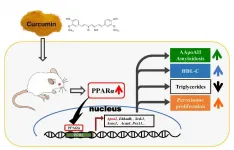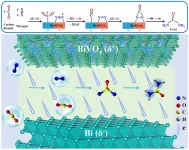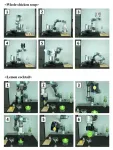Flickering the neural activities with LED lights
A bird's eye view of the brain activity offers new insights into the brain-behavior relationship of the individuals who together form a social entity
2021-02-26
(Press-News.org) Living in a group has clear benefits. As a member of a societal group, one can share resources with the others, seek protection from predators, and forage in an efficient manner. In a 2020 paper published in Science Advances, the neuroscientist Jee Hyun Choi and her student Jisoo Kim of the Brain Science Institute in the Korea Institute of Science and Technology (KIST) argue that there are much more stories about the advantages of group living and social behaviors to the mammalian brain yet to be discovered. Their research was conducted using CBRAIN (Collective Brain Research Aided by Illuminating Neural activity), a unique neuro-telemetric device equipped with LED lights, which enables the measurement and real-time analysis of collective brain activities.
While many experiments were performed to determine the individual behaviors and stances under cost-benefit schemes, the question of how a group of animals form specific social behaviors has been receiving growing interests from the neuroscience community. Understanding how the individuals strategize to produce a concrete group behavior is central to understanding the social groups and their behavioral phenotypes. For instance, recent studies have found that the overall risk imposed on the predators during successful predation attempts is reduced when predation was coordinated as a group.
"In nature, animals are likely to encounter several threats during which behaving as a group may not be beneficial for all group members," explains the senior author Jee Hyun Choi. "Indeed, forming a tight cluster may make some members difficult to avoid predators effectively. We aim to find the collective brain activities which represent behavioral phenotypes emerging from the group in a complex environment and render the brain-behavior link characterized among the group members."
In collaboration with Sung Q Lee of the ETRI in South Korea, the research team developed CBRAIN, a wireless recording device with an edge-illuminated LED that fits on the head of a mouse. This tiny device was implanted in the subcortical brain to collect the voltage signals from specific sub-region of the amygdala called the basolateral amygdala (BLA), which is a brain area known to be highly sensitive to emotional stimuli such as stress and anxiety. When the frequency-specific rhythmic activity on the board occurs during a real-time scanning of the neural activities, the LED on the device is lightened up. These rhythmic events, along with the signals from a group of mice, are transmitted to a receiver. CBRAIN's ability to generate a live report of collective brain activities is striking in contrast to other neural recording devices that analyze the signals after all experiments are completed.
Choi and her team developed experimental protocols to confirm the electrode coordinates and calibrated transient fast rhythms in BLA comprised of the gamma frequency range, called the gamma bursts, across mice. The researchers studied this bursting phenomenon during active and passive displays of fear when a large group of mice was under attack by a spider-like robot. Using CBRAIN, they observed that the occurrence of the gamma bursts during fear-driven behaviors were dependent on the social situations. Mice displayed less gamma bursts when they encountered the robot as a group, and the mice avoided and defended themselves against the robot in a group, just as they do in the nature.
Post-hoc analysis of the movement trajectories computed by deep learning tools revealed that the forms of aggregation are correlated with the gamma activities. While the mice at the edge of the cluster showed higher gamma activity, those located inside the group showed the level of gamma activity similar to the level when no robot was present. "The reduction of gamma bursts in amygdala might reflect the social buffering effect resulting from being together," said Jisoo Kim, the first author of the paper. "However, testing the activity in various ecological situations and different population structures is required to reach a definitive conclusion."
With respect to a newly developed technology and the prospect of socio-behavioral neuroscience, many neuroscientists are optimistic. "We analyze the data acquired by CBRAIN in a way identical to that of conventional neural recordings, but direct observation without first having to record and inspect data gives us a greater degree of freedom in discovering functions of specific brain activities," concludes Choi. "I believe this work serves as an exemplary study highlighting the efficacy of real-time edge-lighting neural recordings of individuals in a group, and the instant linking of a brain and behaviors will expand our understanding of the motives behind complex social behaviors."
INFORMATION:
[Attachments] See images for this press release:

ELSE PRESS RELEASES FROM THIS DATE:
2021-02-26
Curcumin is a polyphenol compound produced by plants of the Curcuma longa species and has been reported to have many physiological activities, which include anti-oxidation, anti-inflammatory, anti-cancer, and anti-amyloid properties. However, the mechanism and network of action are not completely clear. Amyloidosis is a group of diseases characterized by abnormal aggregates of proteins, known as amyloid fibrils, and subsequent deposition in various tissues and organs, such as Alzheimer's disease, immunoglobulin light chain amyloidosis.
In previous studies, curcumin has been ...
2021-02-26
Tohoku University researchers have produced cellulose nanofiber (CNF) synthesized silk naturally through a simple tweak to silkworms' diet. Mixing CNF with commercially available food and feeding the silkworms resulted in a stronger and more tensile silk.
The results of their research were published in the journal Materials and Design on February 1, 2021.
"The idea for our research came to us when we realized the flow-focusing method by which silkworms produce silk is optimal for the nanofibril alignment of CNF," said Tohoku University materials engineer Fumio Narita and co-author of the study.
Silk is usually associated with clothes. But its usage is incredibly diverse thanks to its strength and elastic properties. Its biocompatibility makes it even safe to ...
2021-02-26
An open-source platform, OpenEP co-developed by researchers from the School of Biomedical Engineering & Imaging Sciences at King's College London has been made available to advance research on atrial fibrillation, a condition characterised by an irregular and often fast heartbeat. It can cause significant symptoms such as breathlessness, palpitations and fatigue, as well as being a major contributor to stroke and heart failure.
Current research into the condition involves the interpretation of large amounts of clinical patient data using software written by individual ...
2021-02-26
The centre is part of the German Federal Institute for Risk Assessment (BfR). With the help of microscopy and artificial intelligence, the "E-Morph" test reliably identifies substances that can have oestrogen-like or even opposing effects, according to the research team's report in the specialist journal "Environment International". "E-Morph is a milestone on the way to, one day, replacing animal experiments currently required to detect hormone-like effects," says BfR President Prof. Dr. Dr. Andreas Hensel.
Link to the specialist publication (ScienceDirect):
https://www.sciencedirect.com/science/article/pii/S0160412021000350
Link ...
2021-02-26
A number of brain areas change their activity before we execute a planned voluntary movement. A new study by Umeå University identifies a novel function of this preparatory neural activity, highlighting another mechanism the nervous system can use to achieve its goals.
Voluntary movements are prepared before they are executed. For example, such 'preparation' occurs in the period between seeing a coffee cup and starting to reach for it. Neurons in many areas of the brain change their activity during movement preparation in ways that reflect different aspects of ...
2021-02-26
Eminent scientists warn that key ecosystems around Australia and Antarctica are collapsing, and propose a three-step framework to combat irreversible global damage.
Their report, authored by 38 Australian, UK and US scientists from universities and government agencies, is published today in the international journal Global Change Biology. Researchers say I heralds a stark warning for ecosystem collapse worldwide, if action if not taken urgently.
Lead author, Dr Dana Bergstrom from the Australian Antarctic Division, said that the project emerged from a conference inspired by her ecological research in polar environments.
"I was seeing unbelievably rapid, widespread dieback in the alpine tundra of World Heritage-listed Macquarie Island and started wondering if this ...
2021-02-26
Converting both nitrogen (N2) and carbon dioxide (CO2) into value-added urea molecules via C-N coupling reaction is a promising method to solve the problem of excessive CO2 emissions.
Compared with huge energy consumption industrial processes, the electrochemical urea synthesis provides an appealing route under mild conditions. However, it still faces challenges of low catalytic activity and selectivity.
A research team led by Prof. ZHANG Guangjin from the Institute of Process Engineering (IPE) of the Chinese Academy of Sciences fabricated Bi-BiVO4 Mott-Schottky heterostructure catalysts for efficient urea synthesis at ambient conditions.
This work was published in Angewandte Chemie International ...
2021-02-26
The Korea Institute of Machinery and Materials (KIMM) successfully developed all-round gripper* technology, enabling robots to hold objects of various shapes and stiffnesses. With the new technology, a single gripper can be used to handle different objects such as screwdrivers, bulbs, and coffee pots, and even food with delicate surfaces such as tofu, strawberries, and raw chicken. It is expected to expand applications in contact-free services such as household chores, cooking, serving, packaging, and manufacturing.
*Gripper: A device that enables robots to hold and handle objects, ...
2021-02-26
Memphis, Tenn. (February 25, 2021) - Early diagnosis of Alzheimer's disease has been shown to reduce cost and improve patient outcomes, but current diagnostic approaches can be invasive and costly. A recent study, published in the Journal of Alzheimer's Disease, has found a novel way to identify a high potential for developing Alzheimer's disease before symptoms occur.
Ray Romano, PhD, RN, completed the research as part of his PhD in the Nursing Science Program at the University of Tennessee Health Science Center College of Graduate Health Sciences. Dr. Romano conducted the research through the joint laboratory of Associate ...
2021-02-26
DETROIT (February 25, 2021) - Researchers at Henry Ford Health System, as part of a national asthma collaborative, have identified a gene variant associated with childhood asthma that underscores the importance of including diverse patient populations in research studies.
The study is published in the print version of the American Journal of Respiratory and Critical Care Medicine.
For 14 years researchers have known that a casual variant for early onset asthma resides on chromosome 17, which holds one of the most highly replicated and significant genetic associations with asthma. Henry Ford researchers acknowledged they would not have identified it in this study ...
LAST 30 PRESS RELEASES:
[Press-News.org] Flickering the neural activities with LED lights
A bird's eye view of the brain activity offers new insights into the brain-behavior relationship of the individuals who together form a social entity







